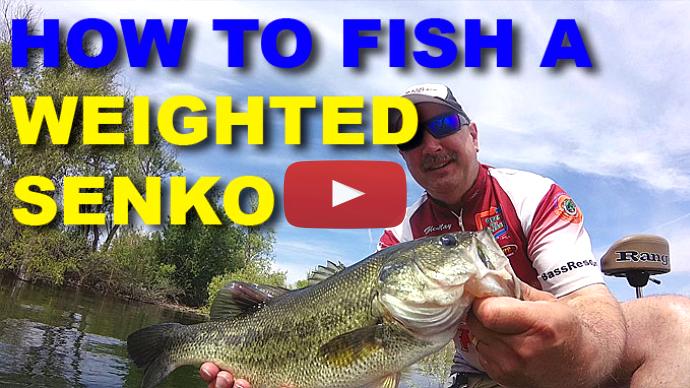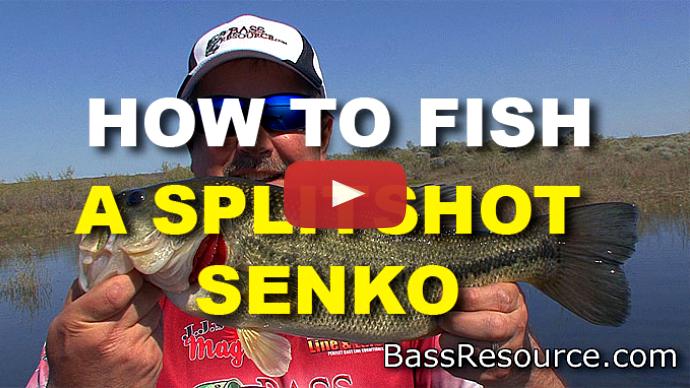There we go. You know it's a lot bigger than your face there dude. It's got a mustache. Today I'm fishing a real clear water reservoir in the middle summer. It looks at all the little fish are out to play today, but that's all right. I'm out here just havin fun. And a day like today it's easy to have 100 fish plus day.
I'm gonna show you how to do this. I'm combining the best of two rigs here. A drop shot and a wacky rig, and I'm jackin' fish all day long doing this. I promise you does catch bigger fish. So today I'm gonna show you how to rig all this up, what kind of equipment I'm using and why. And then I'm gonna take you out on the lake, and I'm gonna to show you how, the different techniques how to use the dropshot wacky rig Senko.
Hey, folks. Glenn May here with BassResource.com. Today, I want to talk to you about fishing, a wacky rig, drop shot, Senko. Yeah, that's right. I'm taking two different rigs, a wacky rig and a drop shot and combining the two for a pretty darn effective bait. Now, if you don't know how to rig a drop shot, I've got a video on how to do that. And it's linked underneath this video for you. You can go take a look at that later. But today, I'm going to talk about the different gear I use, the tackle I use, to fish this, and then I'm going to show you on the water how to fish it.
So first off, I've got this weight here. This is an eighth ounce weight. And you can up in size. You can go up to a quarter ounce or even larger if you want, but that's only if you're fishing deeper water or windy conditions. That's the only time I really upgrade to a heavier weight. But this is just an eighth ounce, and that's the standard I go to all the time. Rigged on that, this is a size 1/0 hook, and of course, we've got the Senko. Look at that, rigged right like that. Pretty cool.
I'm using six-pound co-polymer line, and there's a reason for that. I'm not using fluorocarbon or braid. Braid tends to be more buoyant, and it floats. Not totally floats, but it's more buoyant, and it's going to interfere with the action of this bait. And that's the key thing about fishing a drop shot, is you want it to be as natural as possible. You don't want anything to interfere. As a matter of fact, I use a spin shot hook. That way, it can move around freely as much as possible, and it's not going to interfere with the action of the bait. A lot of people use fluorocarbon when they drop shot for the sensitivity, and I'm not saying you shouldn't do that. If you're comfortable doing that, knock yourself out. Use it all the time. But I use co-polymer because fluorocarbon, it gets heavy and sinks a bit. And again, that interferes with the bait, in my opinion. So that's why I like using co-polymer. It's pretty much neutrally-buoyant, and that way, the bait can do its thing and look as natural as possible.
So six pound, real light line, and because of that, I'm using a medium, light-action rod. It's got lots of flexibility in it here, and you need that. Because when you set the hook and you're fighting the fish back, you don't want to break the line, nor do you want to bend the hook out. So you need that kind of flexibility, medium, light-action rod. So that's the gear. That's how we're rigging it today. Now, let's go fishing.
Okay what I'm fishing here is an area that has rocky bottom with some scattered weeds. Great place to fish the drop shot rig. Now, one of the things I didn't tell you about earlier was on this length. Yeah, we're starting with about 18 inches, but I'll change that length depending on the circumstances I'm fishing in. So for example, if I'm fishing in deeper water, fishing in clearer water, or during the summertime, I might move up to 24 inches, maybe even 30 inches, because the fish, they're actively feeding. They can see it from further distances. They're going to chase it further. So I want to get it up off the bottom a little bit further. Now, if I'm fishing in dingy water or in the wintertime or in shallow water, then I'm going to shorten it up maybe up to 8 or 10 inches because the fish aren't going to chase us as far. I've got to get the bait right down to them. They're a little bit more lethargic, especially in the wintertime. So shortening it up is a great way to go for those situations.
Casting it out, you don't want to throw it really hard because you might throw the bait off the hook. So just a real nice lob cast is alls it takes. You can even underhand pitch it. That works just as well. And once it gets out there, you want to watch the line fall. Let it fall a slack line. Watch it very carefully where the line enters the water because sometimes the fish will bite it on the fall. And the only way you're going to tell is you're going to see that line pop, twitch, jerk, do something odd like that. That's when the fish bite it. So what you're going to do then is reel up the slack and just pull back on it hard. Not a hard hook set, doesn't take much to set the hook on this rig. Again, it's an exposed hook, light wire hook. You're using six pound test line. If you set up really hard, you're probably going to break the line or straighten out that hook. So it's just reel down firmly on it or pull back on the rod and you got them set.
I'm going to show you how to fish this now. You just cast it out there. Wow, that went a long way. That was a light cast. Notice I didn't even throw it very hard. But I'm watching it carefully fall to the bottom, making sure it doesn't twitch. Okay, it hit the bottom. And how do I know that? The line just went slack. It just went limp on me. So now, all I want you to do is just reel up that slack and then hold it in place. That's all you're going to do. There you go. Now I got it. So just hold it in place, and hold it steady, hold it steady, hold it steady. You're not going to move the bait at all. I'm reeling up a little bit because the boat's moving, but that's all you want to do.
I know you think the bait isn't moving much, but if you take your hand and move it and put it in front of your face and hold as steady as you can for 30 seconds, you'll notice that it is moving, no matter how steady you try to hold it. That is being transmitted down the rod, down the line to the bait. In addition, there's always movement. There's always current in any body of water, even if it's a lake, whether it be wind-driven current, wave-driven current. There's always movement, and that is moving the bait as well. Plus if you've got a breeze on the water or those little waves, they're lapping up along your line. And that's being transmitted down to that bait as well. So just holding it steady, that bait is moving around enough that that'll attract the fish and they'll bite. Keep in mind, see, we're not covering a lot of water here. It's a real slow, methodical way of fishing. So this isn't a technique that you want to use to cover a lot of water and to find fish. This is what you use after you've found the fish. You've located an area that they're hanging out on, and you want to pick that apart and get every fish you can. This is the tactic you employ.
So once you've done this for a while, you just hold it steady. Now, alls you going to do is just drop the rod tip a bit down and just shake it. Just shake the tip of the rod. Not much, doesn't take much at all. And then hold it. When you've got their attention, they might come back and bite it. And hold it for as long as you can stand it. Then what you're going to do is just move the bait a little bit, lift up the rod. Reel up the slack, let it drop, and start over again. Just hold steady. Don't do anything, and every once and a while, just shake the rod tip. That's all it's going to take. And that's all there is to it. The drop shot's very, very simple. It doesn't take much to entice the bite, but again, it takes patience. That's what it takes, a lot of patience to fish it.
Now, the areas to fish and when to fish it, during the summertime and in the wintertime, that's when the bulk of the fish are out in the main lake, in a little bit deeper water. So those times of the year, I'll be fishing main lake points, creek channels, creek bends, especially where it swings up close to the shoreline. I'm fishing rock piles, humps, ledges, dropoffs, those type of things. That's where I'm going to be targeting during those times of the year. In the spring and in the fall, that's when most of the fish move up shallow to feed, so I'll go right with them. I'll go to the back of creek channels, back of coves, protected bays, secondary points, and in flats, especially grassy flats. I'll be targeting those areas during those times of the year. If you do that using this technique, again, after you've located the fish, you're going to have a whole heck of a lot of fun.
For more tips and tricks like this, visit BassResource.com



